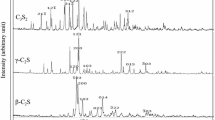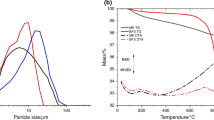Abstract
The calorimetric data of composite binder containing slag or fly ash at different water-to-binder ratios were measured at 298 and 333 K by an isothermal calorimeter. The influences of water-to-binder ratio on the hydration heat characteristics of composite binder were analyzed. Based on the hydration kinetics model, the controlling processes during hydration, nucleation and crystal growth (NG), interactions at phase boundaries (I) and diffusion (D), were determined, and the kinetics parameters were calculated and discussed. The results show that water-to-binder ratio slightly affects the early-stage hydration heat evolution rate and cumulative hydration heat, but a lower water-to-binder ratio results in a lower hydration heat evolution rate and cumulative hydration heat at later stage. The water-to-binder ratio has a great effect on the hydration of composite binder at elevated temperature. Decreasing water-to-binder ratio does not change the hydration mechanism of composite binder, which is NG → I → D at 298 K and becomes NG → D at 333 K. The decrease in water-to-binder ratio increases the apparent rate constant of composite binder containing slag, but the inverse trend is obtained for composite binder containing fly ash during NG process at 298 K. The lower water-to-binder ratio leads to the lower apparent rate constant for composite binder containing large amount of slag or fly ash during NG process at 333 K. Decreasing water-to-binder ratio decreases the apparent rate constant during D process for all samples. The apparent activation energy of composite binder decreases with decreasing water-to-binder ratio.




Similar content being viewed by others
References
Thomas JJ, Biernacki JJ, Bullard JW, et al. Modeling and simulation of cement hydration kinetics and microstructure development. Cem Concr Res. 2011;41:1257–78.
Juenger MCG, Siddique R. Recent advances in understanding the role of supplementary cementitious materials in concrete. Cem Concr Res. 2015;78:71–80.
Lothenbach B, Scrivener K, Hooton RD. Supplementary cementitious materials. Cem Concr Res. 2011;41:1244–56.
De Schutter G. General hydration model for Portland cement and blast furnace slag cement. Cem Concr Res. 1995;25:593–604.
Wang XY, Lee HS, Park KB. A multi-phase kinetic model to simulate hydration of slag-cement blends. Cem Concr Compos. 2010;32:468–77.
Bentz DP. Three-dimensional computer simulation of Portland cement hydration and microstructure development. J Am Ceram Soc. 1997;80:3–21.
Merzouki T, Bouasker M, Khalifa NEH, Mounanga P. Contribution to the modeling of hydration and chemical shrinkage of slag-blended cement at early age. Constr Build Mater. 2013;44:368–80.
Lumley JS, Gollop RS, Moir GK, Taylor HFW. Degrees of reaction of the slag in some blends with Portland cements. Cem Concr Res. 1996;26:139–51.
Bentz DP. Influence of water-to-cement ratio on hydration kinetics: simple models based on spatial considerations. Cem Concr Res. 2006;36:238–44.
Narmluk M, Nawa T. Effect of fly ash on the kinetics of Portland cement hydration at different curing temperatures. Cem Concr Res. 2011;41:579–89.
Castellano CC, Bonavetti VL, Donza HA, Irassar EF. The effect of w/b and temperature on the hydration and strength of blastfurnace slag cements. Constr Build Mater. 2016;111:679–88.
Hu J, Ge Z, Wang K. Influence of cement fineness and water-to-cement ratio on mortar early-age heat of hydration and se times. Constr Build Mater. 2014;50:657–63.
Yan PY, Zheng F, Xu ZQ. Hydration of shrinkage-compensating binders with different compositions and water-binder ratios. J Therm Anal Calorim. 2003;74:201–9.
Aïtcin PC. The importance of the water-cement and water-binder ratios. In: Science and technology of concrete admixtures. 1st edn. England: Woodhead publishing; 2016. p. 3–13.
Živica V. Effects of the very low water/cement ratio. Constr Build Mater. 2009;23:3579–82.
Zhang J, Fan T, Ma H, Li Z. Monitoring setting and hardening of concrete by active acoustic method: effects of water-to-cement ratio and pozzolanic materials. Constr Build Mater. 2015;88:118–25.
Han FH, Zhang ZQ, Wang DM, Yan PY. Hydration kinetics of composite binder containing slag at different temperatures. J Therm Anal Calorim. 2015;121:815–27.
Han FH, Zhang ZQ, Liu JH, Yan PY. Hydration kinetics of composite binder containing fly ash at different temperatures. J Therm Anal Calorim. 2016;124:1691–703.
Han FH, Liu RG, Yan PY. Effect of fresh water leaching on the microstructure of hardened composite binder pastes. Constr Build Mater. 2014;68:630–6.
Pang X. The effect of water-to-cement ratio on the hydration kinetics of Portland cement at different temperatures. In: The 14th international congress on cement chemistry. Beijing, China; 2015.
Bentz DP, Peltz MA, Winpigler J. Early-age properties of cement-based materials: II. Influence of water-to-cement ratio. ASCE J Mater Civil Eng. 2009;21:512–7.
Han FH, Liu JH, Yan PY. Comparative study of reaction degree of mineral admixture by selective dissolution and image analysis. Constr Build Mater. 2016;114:946–55.
Han FH, Liu RG, Wang DM, Yan PY. Characteristics of the hydration heat evolution of composite binder at different hydrating temperature. Thermochim Acta. 2014;586:52–7.
Berliner R, Popovici M, Herwig KW, Berliner M, Jennings HM, Thomas JJ. Quasielastic neutron scattering study of the effect of water-to-cement ratio on the hydration kinetics of tricalcium silicate. Cem Concr Res. 1998;28:231–43.
Kirby DM, Biernacki JJ. The effect of water-to-cement ratio on the hydration kinetics of tricalcium silicate cements: testing the two-step hydration hypothesis. Cem Concr Res. 2012;42:1147–56.
Scrivener KL, Juilland P, Monteiro PJM. Advances in understanding hydration of Portland cement. Cem Concr Res. 2015;78:38–56.
Sakai E, Miyahara S, Ohsawa S, Lee S, Daimon M. Hydration of fly ash cement. Cem Concr Res. 2005;35:1135–40.
Hanehara S, Tomosawa F, Kobayakawa M, Hwang KR. Effects of water/powder ratio, mixing ratio of fly ash, and curing temperature on pozzolanic reaction of fly ash in cement paste. Cem Concr Res. 2001;31:31–9.
Lam L, Wong YL, Poon CS. Degree of hydration and gel/space ratio of high volume fly ash/cement systems. Cem Concr Res. 2000;30:747–56.
Fajun W, Grutzeck MW, Roy DM. The retarding effects of fly ash upon the hydration of cement pastes: the first 24 hours. Cem Concr Res. 1985;15:174–84.
Taylor R, Richardson IG, Brydson RMD. Composition and microstructure of 20-year-old ordinary Portland cement-ground granulated-furnace slag blends containing 0 to 100% slag. Cem Concr Res. 2010;40:971–83.
Tydlitát V, Matas T, Černý R. Effect of w/c and temperature on the early-stage hydration heat development in Portland-limestone cement. Constr Build Mater. 2014;50:140–7.
Han SH, Kim JK, Park YD. Prediction of compressive strength of fly ash concrete by new apparent activation energy function. Cem Concr Res. 2003;33:965–71.
Barnett SJ, Soutsos MN, Millard SG, Bungey JH. Strength development of mortars containing ground granulated blast-furnace slag: effect of curing temperature and determination of apparent activation energies. Cem Concr Res. 2006;36:434–40.
Acknowledgements
Authors would like to acknowledge the National Natural Science Foundation of China (No. 51278277), the Postdoctoral Science Foundation of China (Nos. 2015M580992 and 2016T90036), Open Fund of State Key Laboratory of High Performance Civil Engineering Materials (No. 2015CEM010), and Fundamental Research Funds for the Central Universities (No. FRF-TP-15-108A1).
Author information
Authors and Affiliations
Corresponding authors
Rights and permissions
About this article
Cite this article
Han, F., Zhang, Z., Liu, J. et al. Effect of water-to-binder ratio on the hydration kinetics of composite binder containing slag or fly ash. J Therm Anal Calorim 128, 855–865 (2017). https://doi.org/10.1007/s10973-016-6015-4
Received:
Accepted:
Published:
Issue Date:
DOI: https://doi.org/10.1007/s10973-016-6015-4




